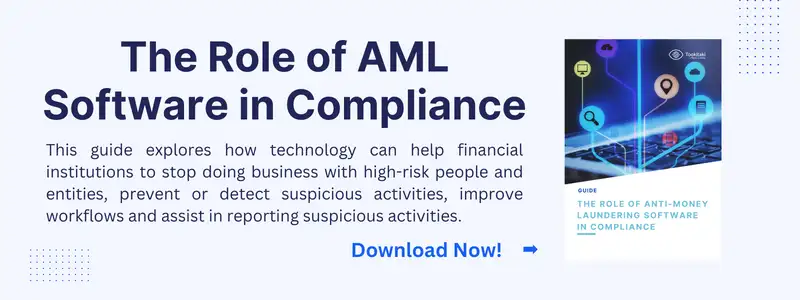In the complex world of finance, AML regulations play a pivotal role. They serve as a bulwark against financial crime, ensuring the integrity of financial systems.
Understanding these regulations is crucial for financial institutions. It's not just about compliance, but also about safeguarding the institution's reputation and trustworthiness.
This article delves into the intricacies of AML regulations. It explores their global significance, the role of key legislation like the Bank Secrecy Act, and the importance of international bodies in setting AML standards.
We'll also examine the components of an effective AML compliance program. From risk assessments to the role of the AML compliance officer, we'll provide actionable insights for implementing robust AML strategies.
The consequences of non-compliance are severe, and we'll highlight some case studies to underscore this point. Finally, we'll look at the future of AML regulations and the challenges that lie ahead.
Whether you're a compliance officer, a senior manager in a financial institution, or a legal professional, this article will equip you with a comprehensive understanding of AML regulations and compliance strategies.
The Global Landscape of AML Regulations
AML regulations are a global phenomenon. They are designed to prevent money laundering, a crime that knows no borders.
These regulations vary from country to country, reflecting the unique legal and economic contexts of each jurisdiction. However, they share a common goal: to deter, detect, and disrupt money laundering activities.
In the United States, the Bank Secrecy Act forms the cornerstone of AML efforts. In the European Union, the AML Directive sets out the regulatory framework.
Internationally, bodies like the Financial Action Task Force (FATF) play a crucial role. They set standards and promote effective implementation of legal, regulatory, and operational measures for combating money laundering.
Here's a brief overview of the global AML landscape:
- United States: Bank Secrecy Act
- European Union: AML Directive
- International: Financial Action Task Force (FATF)
The Bank Secrecy Act and the US Approach to AML
In the United States, the Bank Secrecy Act (BSA) is the primary legislation for combating money laundering. Enacted in 1970, the BSA requires financial institutions to assist U.S. government agencies in detecting and preventing money laundering.
Under the BSA, financial institutions must
Key Components of an Effective AML Compliance Program
An effective AML compliance program is a must for any financial institution. It's not just about adhering to regulations. It's about protecting the institution and its customers from financial crime.
The first step in building an AML program is conducting a risk assessment. This helps identify potential areas of money laundering risk within the organization.
Next, the institution must implement Customer Due Diligence (CDD) procedures. This involves verifying the identity of customers and understanding the nature of their transactions.
A crucial role in the AML program is played by the AML Compliance Officer. This individual is responsible for overseeing the program and ensuring its effectiveness.
Here are the key components of an effective AML compliance program:
- Risk Assessment
- Customer Due Diligence (CDD)
- AML Compliance Officer
Risk Assessments: The Foundation of AML Strategy
Risk assessments are the foundation of any AML strategy. They help identify and understand the potential areas of money laundering risk within an organization.
The risk assessment process involves evaluating the products, services, customers, and geographic locations of the institution. The goal is to identify where the institution is most vulnerable to money laundering.
Once these vulnerabilities are identified, the institution can take steps to mitigate these risks. This might involve enhancing controls, improving monitoring, or providing additional training to staff.
Customer Due Diligence (CDD) and Identifying Beneficial Owners
Customer Due Diligence (CDD) is another key component of an AML program. It involves verifying the identity of customers and understanding the nature of their transactions.
CDD procedures help prevent money laundering by ensuring that the institution knows who its customers are. This includes identifying the beneficial owners of accounts and understanding the purpose and intended nature of the customer relationship.
In addition, CDD procedures help the institution monitor customer transactions for suspicious activity. This allows the institution to detect and report potential money laundering activities.
The Role of the AML Compliance Officer
The AML Compliance Officer plays a crucial role in the AML program. This individual is responsible for overseeing the program and ensuring its effectiveness.
The AML Compliance Officer's responsibilities include developing and implementing the AML program, conducting risk assessments, and overseeing CDD procedures. They also ensure that the institution is in compliance with all relevant AML regulations.
In addition, the AML Compliance Officer is responsible for training staff on AML procedures and regulations. They also report to senior management on the effectiveness of the AML program.
Reporting and Monitoring: Detecting and Reporting Suspicious Activity
Detecting and reporting suspicious activity is a key part of AML compliance. Financial institutions must monitor transactions to identify any that might indicate money laundering.
This involves looking for patterns or behaviours that are out of the ordinary. For example, a customer who makes large cash deposits could be trying to avoid detection.
Once a suspicious activity is detected, it must be reported. In the US, this is done by filing a Suspicious Activity Report (SAR) with the Financial Crimes Enforcement Network (FinCEN).
The goal of this process is to prevent money laundering and other financial crimes. By detecting and reporting suspicious activity, financial institutions can help law enforcement catch criminals and protect the integrity of the financial system.
Techniques and Tools for Monitoring Transactions
Monitoring transactions is a complex task. It involves analyzing large volumes of data to identify suspicious patterns or behaviours.
To do this effectively, many financial institutions use specialized software. These tools can automate the process of monitoring transactions, making it more efficient and accurate.
For example, some tools use machine learning algorithms to identify patterns that might indicate money laundering. These patterns might be too complex for a human to detect.
In addition to software, financial institutions also use other techniques to monitor transactions. These might include setting thresholds for certain types of transactions, or monitoring transactions from high-risk countries or sectors.
Legal Obligations: Reporting and Recordkeeping
Financial institutions have legal obligations when it comes to detecting and reporting suspicious activity. These obligations are set out in AML regulations.
In the US, for example, financial institutions must file a Suspicious Activity Report (SAR) whenever they detect a transaction that might indicate money laundering. This report must be filed with the Financial Crimes Enforcement Network (FinCEN).
In addition to reporting, financial institutions also have recordkeeping obligations. They must keep records of all transactions, as well as any actions taken in response to a detected suspicious activity.
These legal obligations are not just about compliance. They are about helping law enforcement catch criminals and protect the integrity of the financial system.
The Consequences of Non-Compliance
Non-compliance with AML regulations can have serious consequences. Financial institutions that fail to comply can face hefty fines and sanctions.
In some cases, non-compliance can also lead to criminal charges. This can damage the reputation of the institution and erode trust among customers and investors.
Moreover, non-compliance can also expose the institution to the risk of being used for money laundering. This can have far-reaching implications, including potential involvement in criminal investigations and proceedings.
Case Studies: The Cost of AML Failures
There are numerous examples of financial institutions facing severe penalties for AML failures. One notable case is that of HSBC, which in 2012 was fined $1.9 billion for AML violations.
Another case is that of Deutsche Bank, which in 2017 was fined $630 million for failing to prevent $10 billion in suspicious trades from Russia. These cases highlight the significant financial and reputational risks associated with AML non-compliance.
These case studies serve as a stark reminder of the importance of robust AML compliance. They underscore the need for financial institutions to invest in effective AML programs and to ensure that they are fully compliant with all relevant regulations.
The Future of AML Regulations and Compliance
The landscape of AML regulations and compliance is constantly evolving. This is driven by changes in the financial sector, advancements in technology, and the emergence of new money laundering techniques.
As such, financial institutions must remain vigilant and proactive. They need to stay abreast of changes in AML regulations and adapt their compliance programs accordingly.
Moreover, they must also invest in new technologies and tools. These can enhance their ability to detect and prevent money laundering, and ensure their compliance with AML regulations.
Emerging Technologies and the Evolution of AML
Emerging technologies are playing a significant role in the evolution of AML. For instance, artificial intelligence and machine learning are being used to analyze transaction data and identify suspicious patterns.
Blockchain technology is also being explored for its potential in enhancing transparency and traceability in financial transactions. This can help in the detection and prevention of money laundering.
However, these technologies also present new challenges. Financial institutions must ensure that their use of these technologies complies with AML regulations and does not infringe on customer privacy rights.
Preparing for Changes and Challenges Ahead
Preparing for the future of AML involves more than just keeping up with changes in regulations and technology. It also requires a shift in mindset.
Financial institutions must foster a culture of compliance. This involves training employees on AML regulations and procedures, and instilling a sense of responsibility and accountability.
Moreover, they must also adopt a risk-based approach to AML compliance. This involves identifying and assessing their specific risks of money laundering, and tailoring their AML programs to address these risks. This approach can enhance the effectiveness of their AML efforts and ensure their compliance with AML regulations.
Proactive Strategies for Future AML Compliance
Tookitaki offers AML solutions like Transaction Monitoring, Smart Screening, Customer Risk Scoring, and Case Manager, specifically crafted to help financial institutions lower their AML compliance expenses. Through its AFC Ecosystem, Tookitaki facilitates efficient information exchange among financial institutions, enhancing the overall effectiveness and precision of the AML compliance process.
Financial institutions must adopt a proactive stance in reducing AML compliance costs. Non-compliance can be costly, while the advantages of cost reduction, streamlined processes, and heightened efficiency make it a prudent investment. To gain control over your AML compliance expenses, we invite you to request a demo of Tookitaki's solutions and experience the benefits firsthand.
Anti-Financial Crime Compliance with Tookitaki?






